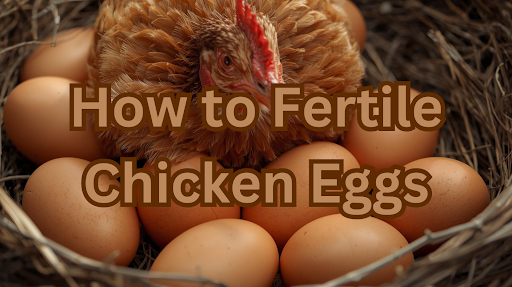How to Fertile Chicken Eggs: Your Step-by-Step Beginner’s Guide to Hatching
There’s a special kind of magic in hatching your own chicks. That moment a tiny, damp beak first pips through an eggshell, followed by the determined cheeping of a new life, is a reward like no other for a homesteader or backyard chicken keeper. But that magic isn’t random—it’s a fascinating science. The journey of learning how to transform fertile chicken eggs into fluffy chicks is one of patience, precision, and a little bit of wonder.
Many beginners are intimidated, thinking it requires expensive equipment and a veterinary degree. I’m here to tell you that’s not true. With the right knowledge, anyone can learn how to fertilize chicken eggs successfully. This comprehensive guide will walk you through every critical step, from the very first requirement—getting a fertile egg—to the triumphant hatch day.
What Makes an Egg Fertile, Anyway?
Before we dive into the “how,” we must understand the “what.” A fertile egg is simply an egg that has been fertilized by a rooster. Without a rooster, the eggs your hens lay are biologically identical to what you buy at the grocery store—they will never develop into a chick. If you’re learning how to fertile chicken eggs, the key is, unsurprisingly, a rooster. A single, healthy rooster can easily service a flock of 10–12 hens. The fertility rate isn’t 100%, so don’t expect every single egg collected to be viable. This is the first crucial lesson in understanding how fertile chicken eggs work; it starts in the flock itself.
Step 1: Sourcing Your Fertile Eggs
Your success begins with the quality of the egg. You have two options:
- Using Your Own Flock: This is ideal if you have a rooster. You’ll know the eggs are fresh and how the birds are cared for.
- Purchasing from a Reputable Breeder: This is a great way to get specific breeds. Look for breeders with good reviews and who ship eggs quickly and safely.
What to look for in a good hatching egg:
- Freshness: Eggs should be no more than 7-10 days old, stored pointed-end down.
- Size: Normal size for the breed. Avoid unusually large or small eggs.
- Shape: A good, classic egg shape. Oddly shaped eggs often have thin shells or other issues.
- Shell Quality: Clean, uncracked, and smooth. Avoid washing eggs, as this removes the protective bloom. Gently sand off any dirt if necessary.
Understanding where to source viable eggs is the foundational step in learning how fertile chicken eggs hatch.
Step 2: Choosing Your Incubation Method
You have two main paths for incubation: using a broody hen or an artificial incubator. Each has its pros and cons.
The Natural Method: The Broody Hen
A broody hen is a hen with a strong instinct to sit on eggs and hatch them. She’ll do all the work—regulating temperature, turning the eggs, and even teaching the chicks once they hatch.
Pros:
- Hands-off and energy-free.
- The hen is a natural expert at how fertile chicken eggs need to be cared for.
- Great for a small clutch of eggs.
Cons:
- You need a broody hen, which isn’t always available. Just like asking How Old Do Kittens need
- to be for certain milestones,timing and readiness matter here too.
- You can’t control the environment as easily (e.g., predators,temperature fluctuations). She will only hatch a small number of eggs
The Controlled Method: Using an Incubator
An incubator gives you complete control over the hatching process, which is why most beginners learning how to fertilize chicken eggs hatch choose this method. There are two main types:
- Still-Air Incubator: Less expensive, but temperature is less consistent. Better for experienced users.
- Forced-Air Incubator: Has a fan to circulate air, creating a uniform temperature. This is highly recommended for beginners.
The core principle of how fertile chicken eggs develop in an incubator revolves on three critical factors, often called the “Holy Trinity of Incubation.”
| Factor | Ideal Setting | Why It’s Critical |
| Temperature | 99.5°F (37.5°C) for forced-air incubators. | Even a 1-degree fluctuation can cause developmental issues or death. Temperature is the most vital aspect of how to fertile chicken eggs incubate properly. |
| Humidity | 40-50% for days 1-18; 65-75% for days 19-21. | Controls moisture loss from the egg. Too dry, and the chick can stick to the shell; too wet, and it can drown. |
| Turning | At least 3-5 times a day until day 18. | Prevents the embryo from sticking to the shell membrane and ensures proper development. |
Step 3: The 21-Day Incubation Process – A Day-by-Day Guide
Here’s a simplified timeline of what happens inside the egg. This demystifies the process and helps you understand exactly how fertile chicken eggs develop.
- Days 1-3: The embryo begins to form. Major organs like the heart start developing.
- Days 4-7: Blood vessels become visible. The egg’s air cell forms at the blunt end.
- Days 8-14: The beak, toes, and feathers begin to form. The embryo starts to look like a chick.
- Days 15-18: The chick grows rapidly, positioning itself for hatching. The turning mechanism stops on day 18. This is called “lockdown.”
- Days 19-21: Hatch Day! The chick pips internally into the air cell, then pips externally through the shell. The hatching process can take 12-24 hours.
The Art of Candling: Your Window into the Egg
Candling is the process of shining a bright light through the egg to see inside. It’s the best way to check your progress and understand how fertile chicken eggs are developing. You should candle around day 7 and day 14.
- Day 7: You should see a web of blood vessels and a dark spot (the embryo). If the egg is clear, it’s infertile. If you see a blood ring, the embryo has died.
- Day 14: The egg should be much darker, with the air cell clearly visible at the blunt end.
Pro Tip: Be quick and gentle when candling to avoid chilling the eggs.
Step 4: Lockdown and the Miracle of Hatch Day
On day 18, you enter the “lockdown” phase. This is a critical shift in your strategy for how fertile chicken eggs are handled.
- Stop turning the eggs.
- Increase the humidity to 65-75%.
- Do NOT open the incubator. The chicks are positioning themselves to hatch and need a stable, humid environment.
Then, you wait. You’ll first see a “pip”—a small hole the chick makes from the inside. Then, it will start “zipping,” cracking the shell in a line all the way around. Do not help the chick out. The struggle is essential for it to absorb its yolk sac and strengthen its muscles. Interfering can cause fatal bleeding.
The entire guide on how to fertilize chicken eggs hatch culminates in this patient waiting. It’s the hardest part, but the most rewarding, much like understanding How Long to Leave Second Skin when caring for a fresh tattoo—timing, patience, and restraint make all the difference.
Troubleshooting Common Problems

Even with perfect preparation, things can go wrong. Here are common issues when figuring out how to fertile chicken eggs hatch:
- Low Hatch Rate: Often due to incorrect temperature, humidity, or poor egg quality.
- Chicks Pipped but Died: Usually a humidity problem during lockdown—either too low (chick got stuck) or too high (chick was weak).
- Malformed Chicks: Often linked to temperature fluctuations during incubation.
The ultimate guide on how to fertilize chicken eggs must emphasize that record-keeping is your best friend. Note your settings and outcomes to improve with each hatch.
Conclusion: Your Flock Awaits
Learning how to fertile chicken eggs and hatch them is a journey that connects you to the ancient cycle of life. It’s a process that teaches patience, observation, and respect for nature’s intricacies. While this guide provides the blueprint, your own experience will be your best teacher.
Don’t be discouraged by setbacks. Every seasoned chicken keeper has stories of hatches that didn’t go as planned. The key is to start, be meticulous, and embrace the learning process. Before you know it, you’ll have a brooder full of cheeping chicks that you helped bring into the world.
Read More Like This: How Long Does It Take to Get
Ready to Start Your Hatching Adventure?
I’d love to hear from you! What chicken breeds are you dreaming of hatching? Do you have any questions about the process that we didn’t cover? Partake your studies and gests in the commentary below. And if you’re looking for more beginner-friendly chicken-keeping tips, explore our complete guide to raising backyard chickens. Happy hatching
Frequently Asked Questions (FAQs)
Can I hatch supermarket eggs?
No, you cannot. Supermarket eggs are almost always unfertilized because commercial egg-laying farms do not keep roosters with the hens. The first and most critical step in learning how to hatch fertile chicken eggs is sourcing actual fertile eggs from a flock that includes a rooster.
What is the difference between a fertile egg and a regular egg?
Visually, there is no difference when you crack them open for eating. A fertile egg has the genetic potential to develop into a chick because a rooster has fertilized it, but it requires the specific conditions of incubation to begin development. Without incubation, it is nutritionally identical to an unfertilized egg. If you’re learning how to fertile chicken eggs, the key distinction is biological, not visual, until incubation starts.
Is it okay to help a chick that is struggling to hatch?
It is strongly advised not to help a chick hatch. Anyone learning how to fertile chicken eggs should understand that the hatching process itself is a vital workout for the chick. This effort allows it to absorb the yolk sac properly and ensures the circulatory system transitions as it should. Interfering too early—especially when you’re still figuring out how to fertile chicken eggs and manage the incubation process—can lead to fatal bleeding if the membranes haven’t fully absorbed.
Patience is the most important tool when mastering how to fertile chicken eggs and ensuring they hatch successfully. Only in very rare cases—after many hours of no progress and clear signs of distress—should assisted hatching be considered, and only by someone experienced.
Why did my eggs start developing but then die?
This is a common and heartbreaking issue, often called “quitting.” It usually points to problems during incubation. The most common causes are inconsistent temperature, incorrect humidity (leading to either excessive moisture loss or insufficient loss), or insufficient turning of the eggs in the first 18 days. If you’re studying how to fertile chicken eggs successfully, reviewing your incubation logs for temperature and humidity stability is the best way to troubleshoot this aspect of how fertile chicken eggs develop fully.
How long can I store fertile eggs before incubating them?
You can store fertile eggs for up to 7-10 days before incubation begins. Storage conditions are crucial: keep them in a cool (55-60°F / 13-15°C), humid place, and always store them with the pointed end facing slightly downwards. Fertility decreases significantly after a week. For the best hatch rates when learning how to fertilize chicken eggs, it’s ideal to set eggs that are 3 days old or less.

